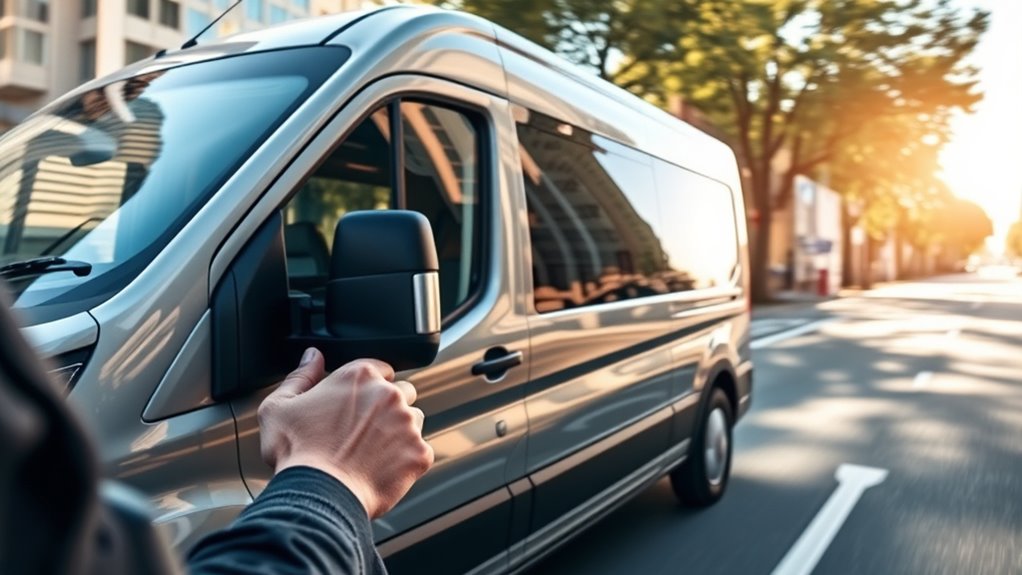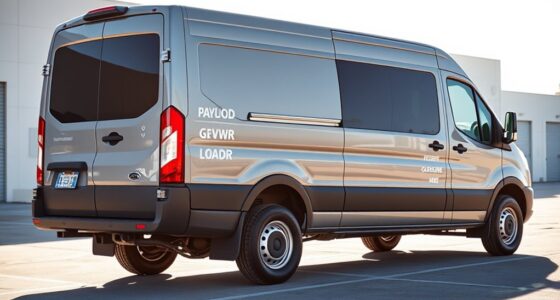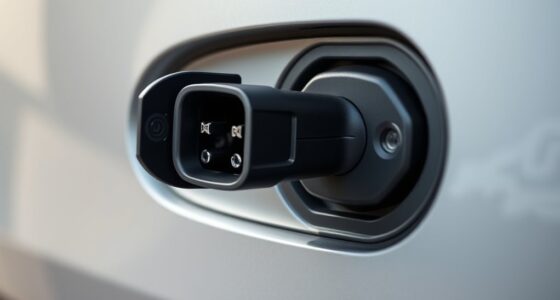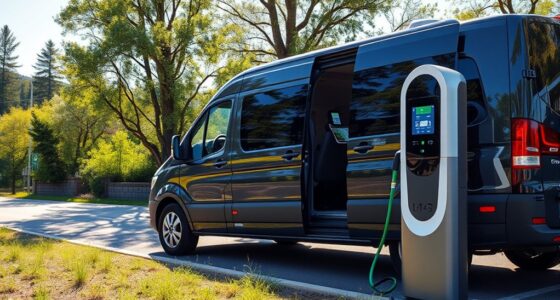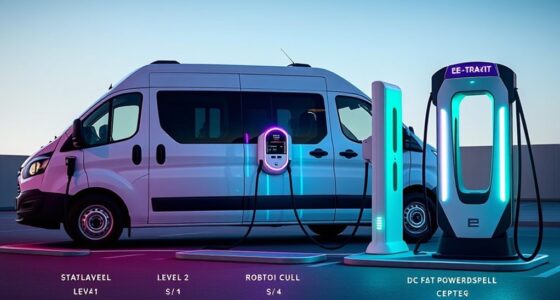On the E‑Transit, regenerative braking offers different modes to suit your driving style. Standard mode provides gentle deceleration, while high regenerative mode delivers more noticeable deceleration by recapturing more energy. You might feel a slight drag when you lift off the accelerator, especially in higher settings. Adjusting these modes can help you optimize comfort and efficiency, especially in city stop-and-go traffic. If you want to learn how to get the most from these options, keep exploring further.
Key Takeaways
- E‑Transit offers multiple regenerative braking modes, such as standard and high, to control energy recovery and deceleration feel.
- Standard mode provides a gentle, almost imperceptible deceleration for smooth driving, while high mode offers more aggressive deceleration.
- Drivers can activate or adjust regenerative settings via vehicle controls or paddle shifters, depending on the model.
- Higher regenerative modes are ideal for city driving, maximizing energy recapture and reducing brake wear.
- The system is designed to deliver a natural, seamless deceleration experience that enhances efficiency without sacrificing comfort.

Regenerative braking on the E‑Transit is a key feature that enhances efficiency by recapturing energy during deceleration. When you lift off the accelerator or press the brake, the system switches from propulsion to regeneration, converting the vehicle’s kinetic energy into electrical energy that recharges the battery. This process extends your range and reduces wear on traditional friction brakes, making your vehicle more economical and eco-friendly.
Regenerative braking on the E‑Transit recovers energy during deceleration, boosting range and reducing brake wear for a more efficient drive.
As you drive, you’ll notice how seamlessly the system works—during gentle deceleration, it feels almost natural, providing a smooth handover from acceleration to deceleration without abrupt changes.
The E‑Transit offers different regenerative braking modes, giving you control over how much energy you recapture and how the vehicle behaves when slowing down. In most cases, you’ll find a standard mode that balances energy recovery with a comfortable driving experience. This mode allows you to lift off the accelerator and feel a slight deceleration, almost like coasting, which encourages you to drive more efficiently without sacrificing comfort.
If you’re seeking more aggressive energy recovery, some models allow you to switch to a high regenerative mode. In this setting, you’ll experience a more noticeable deceleration when you lift off, which can be advantageous in stop-and-go city traffic or when trying to maximize range.
You can activate regenerative braking modes through vehicle settings or paddle shifters, depending on your model. Many drivers find that adjusting the level of regeneration helps tailor their driving experience. For example, using a higher regeneration setting in urban environments allows you to slow down without constantly applying the brake, minimizing brake wear and increasing your overall efficiency.
Conversely, in highway driving, a lower setting might feel more natural, letting you coast comfortably without excessive deceleration.
The feel of regenerative braking varies depending on the mode you select. In standard mode, it’s subtle—almost imperceptible—giving you a smooth, consistent deceleration. In high regeneration mode, the deceleration becomes more assertive, giving you a more immediate sense of slowing down when you lift off, which can take some getting used to but offers the benefit of reducing reliance on traditional braking, which translates into less maintenance and longer-lasting brake components. Regularly testing the system and adjusting your driving style can help you optimize energy recovery and comfort.
This can take some getting used to but offers the benefit of reducing reliance on traditional braking, which translates into less maintenance and longer-lasting brake components. Over time, you’ll likely develop a driving rhythm that maximizes energy recovery without sacrificing comfort.
Ultimately, regenerative braking on the E‑Transit empowers you to drive more efficiently and sustainably. By understanding the different modes and how they influence the vehicle’s feel, you can fine-tune your driving experience to suit your needs—whether you’re aiming for maximum range, comfort, or a blend of both.
It’s a smart system designed to work seamlessly with your driving style, helping you get the most out of your electric van every time you hit the road.
Frequently Asked Questions
Can Regenerative Braking Be Customized for Different Driving Styles?
Yes, regenerative braking can be customized for different driving styles. You can adjust the level of recovery, allowing you to prioritize smoother stops or more aggressive deceleration.
Many vehicles let you choose between different modes, like eco or sport, to match your driving preferences. By customizing these settings, you optimize energy recovery and driving comfort, making your E‑Transit more efficient and tailored to how you like to drive.
How Does Regenerative Braking Affect Overall Vehicle Maintenance?
Regenerative braking transforms your vehicle’s maintenance by drastically reducing brake wear, almost like magic! You’ll find brake components last forever, saving you countless repair trips and expenses.
This system also keeps your brake fluid fresh and prevents overheating. With less friction and fewer parts needing replacement, your E-Transit stays in top shape longer than you ever imagined.
Making maintenance simpler, cheaper, and way more reliable.
Is Regenerative Braking Effective in All Weather Conditions?
Regenerative braking is generally effective in most weather conditions, but its performance can decrease in icy or snowy conditions. When roads are slick, you might notice less deceleration from regeneration alone, requiring traditional braking.
You should stay alert and adjust your driving accordingly. In rain or cold weather, regenerative braking still works well, but always guarantee your vehicle’s systems are properly maintained for best performance and safety.
What Training Is Required for Drivers to Optimize Regenerative Braking?
You should receive training that covers how regenerative braking works and when to use it effectively. This includes understanding different modes, recognizing ideal braking scenarios, and avoiding abrupt stops that reduce efficiency.
Practice smooth deceleration techniques and learn to anticipate traffic flow for maximum energy recovery. Regularly review manufacturer guidelines and participate in refresher courses to stay updated on best practices, ensuring you get the most out of regenerative braking.
How Does Regenerative Braking Impact Battery Longevity Over Time?
Regenerative braking can extend your battery’s lifespan by reducing wear on traditional braking components and recycling energy.
However, frequent deep cycling may gradually degrade the battery’s capacity over time.
To maximize longevity, you should drive smoothly, avoid aggressive braking, and follow manufacturer guidelines.
Proper use of regenerative braking helps maintain ideal battery health, ensuring your vehicle remains reliable and efficient for longer periods.
Conclusion
Now that you understand the modes and feel of regenerative braking on the e-Transit, you’re better equipped to harness its full potential. Remember, it’s all about working smarter, not harder—like turning a challenge into an opportunity. Embracing these features lets you maximize efficiency and extend your vehicle’s range. So, don’t let the opportunity slip away; seize the moment and make regenerative braking work for you, turning every stop into a chance to recharge.
